
- •Cooling Reactions
- •Warming Reactions
- •Methods of body temperature measurements
- •In order to assist you with reading the patient's temperature, most thermometers have an arrow pointing to the line denoting the average normal body temperature (37º c or 98.6º f).
- •Figure. Reading a glass thermometer.
- •Figure. Shaking down a glass thermometer
- •Figure. Three locations for taking temperatures
- •Figure. Oral and rectal glass thermometers.
- •When an Oral Temperature Should Be Taken
- •When an Oral Temperature Should Not Be Taken
- •Figure. A thermometer tray.
- •2. Examine Thermometer. Make sure that the thermometer you are going to use is actually an oral thermometer and that the thermometer has been shaken down.
- •When an Axillary Temperature Should Be Taken
- •Infection. This is the most common cause of a fever. Infections may affect the whole body or a specific body part (localized infection).
- •Very high fever – 40-41˚ с;
- •Fever stages
- •Care of the patient with fever
Infection. This is the most common cause of a fever. Infections may affect the whole body or a specific body part (localized infection).
Medicines, such as antibiotics, narcotics, barbiturates, antihistamines, and many others. These are called drug fevers. Some medicines, such as antibiotics, raise the body temperature directly; others interfere with the body's ability to readjust its temperature when other factors cause the temperature to rise.
Severe trauma or injury, such as a heart attack, stroke, heat exhaustion or heatstroke, or burns.
Other medical conditions, such as arthritis, hyperthyroidism, and even some cancers, such as leukemia, Hodgkin’s lymphoma, and liver and lung cancer.
Depend on character of body temperature elevation the following fever types are differentiated:
A
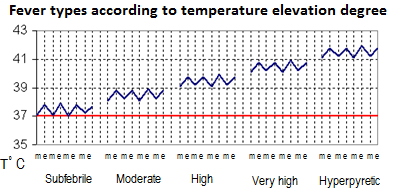 ccording
to fever degree (figure):
ccording
to fever degree (figure):
Subfebrile temperature – 37-38˚ С;
Moderate fever – 38-39˚ С;
High fever – 39-40˚ С;
Very high fever – 40-41˚ с;
Hyperpyretic fever – more than 41˚ С.
According to duration:
Transient (ephemeral) fever – during a few hours, but not more than 1-2 days;
Acute fever – to 15 days;
Subacute fever – to 45 days;
Chronic fever – over 45 days.
According to character of daily variations:
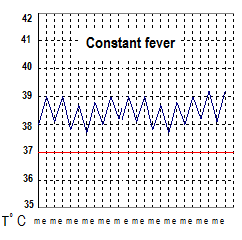
Constant (permanent) fever – high, not less than 39˚С, long standing with insignificant temperature variations (not more 1˚С) body temperature elevation; is typical to the typhoid fever, relapsing fever, pneumonia.
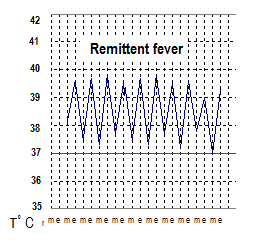
Remittent fever – fever with daily temperature variations that exceed 2 ˚С; body temperature decreased to 38˚С (without lowering to the normal level); is typical to bronchopneumonia, purulent diseases.
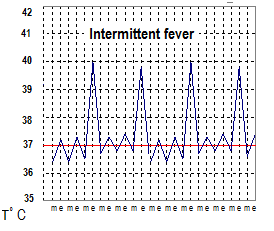
Intermittent fever – fever with alternation during the day of elevated body temperature periods (39-40 ˚С) with periods of subnormal temperature (less than нижче 36 ˚С) followed by 2-3 days fever again; is typical to malaria.
R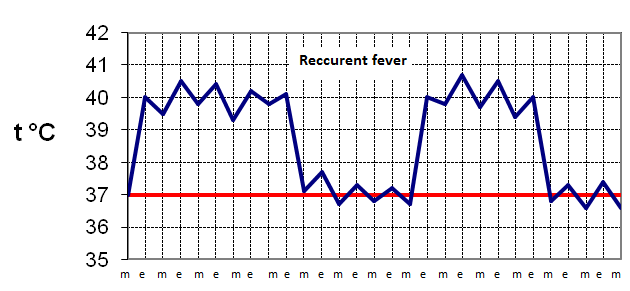 ecurrent
fever
– fever
with
correct
change of period high fever (to 39-40˚
С)
with period of abrupt lowering of the temperature to the normal level
for some days, and followed again by fever period with subsequent
lowering of the body temperature; is pathognomic to relapsing fever.
ecurrent
fever
– fever
with
correct
change of period high fever (to 39-40˚
С)
with period of abrupt lowering of the temperature to the normal level
for some days, and followed again by fever period with subsequent
lowering of the body temperature; is pathognomic to relapsing fever.
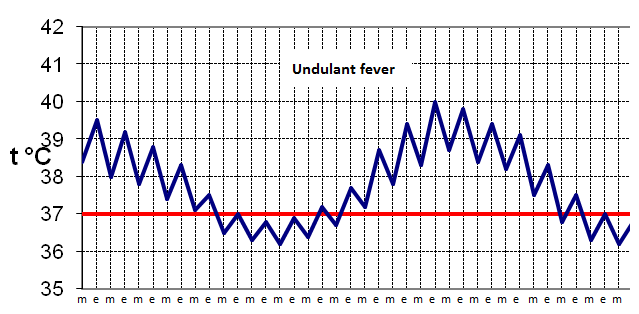
Undulant fever is a fever with the change of periods of gradual growth of temperature to the high level and its gradual decline to the subfebrile or normal level; characteristic for brucellosis, megakaryoblastoma (Hodgkin’s disease).
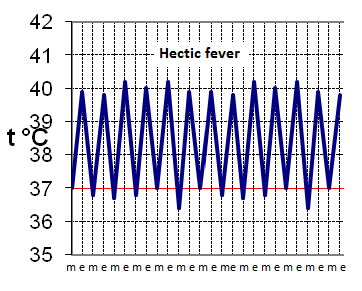
Hectic fever – prolonged fever with large daily variations in 3-4˚С and quick temperature decline to normal ranges and lower; these variations are associated with significant perspiration, exhausting weakness, repeated 2-3 per day; characteristic of final stage of tuberculosis, sepsis.
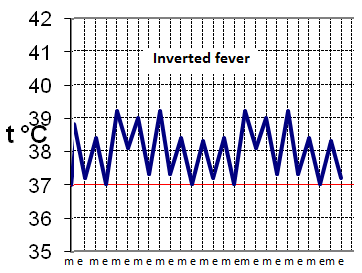
Inverted fever – fever with inverse type of daily variation of temperature level in which morning temperature is higher than evening, usually associated with exhausting fever; is typical to severe tuberculosis, septic conditions.
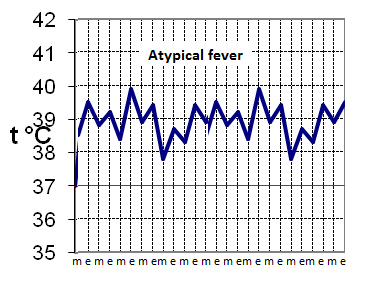 Atypical
fever –
fever of indefinite duration with incorrect and various daily
allowance variations; observed at many diseases (flu, diphtheria,
dysentery, acute rheumatism, endocarditis, tuberculosis, pleurisy,
sepsis and other).
Atypical
fever –
fever of indefinite duration with incorrect and various daily
allowance variations; observed at many diseases (flu, diphtheria,
dysentery, acute rheumatism, endocarditis, tuberculosis, pleurisy,
sepsis and other).
